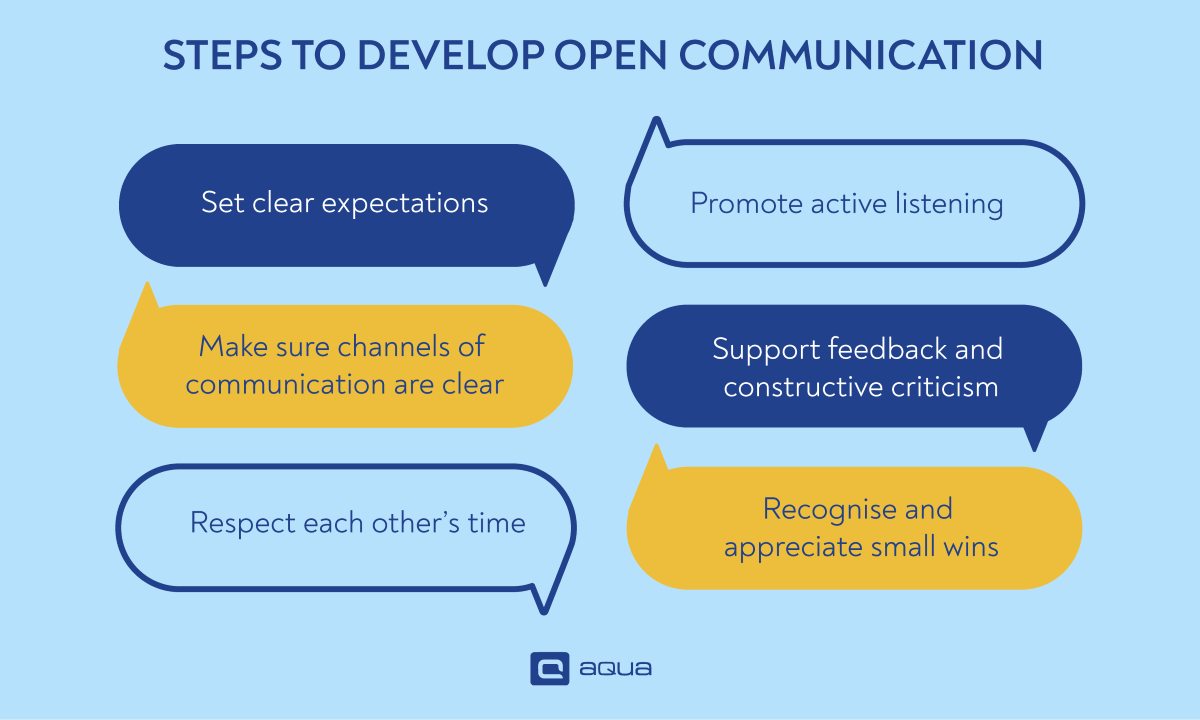Successful software development depends on great collaboration between the QA and development teams. The QA team is responsible for reporting bugs, while the development team needs to fix them to achieve higher quality. So it is normal to have misunderstandings in QA and developer relationships.
Relationships are always 2-way roads; each side must play a massive part in seamless collaboration and teamwork. There is no shying away from this.
Although it might seem like a complicated process to focus on better communication between testing and development teams, it all comes down to simple, actionable steps. In this article, we will emphasise these steps to help you create a better work environment and minimise conflicts and misunderstandings while delivering the desired results.
#1. Create an environment with open communication
Sounds cliche, doesn’t it? Almost every article you will see on the internet about better teamwork and relationships will include one criterion: communication. Better communication does not necessarily mean better relationships. But communication is more than just having daily calls/messages about the development process. Here is how to create better QA and development team communication:
- Clear the air early: set expectations through proper channels and get everyone talking. Make joint planning, daily stand-ups and those post-project chats (yes, the retrospectives!) non-negotiable for both QA and developers. Companies that establish these rhythms see defect rates drop significantly.
Developers who understand testing priorities catch issues before they become expensive fixes, sometimes saving weeks of back-and-forth. - Make sure the team members know whom to contact in case of concerns.
- Respect each other’s time by avoiding calls when you can make your point with an email or message. Also, prioritise face-to-face conversations instead of messaging when the issue or concern is massive.
- Promote active listening during communication, where everyone understands what issue is being raised.
- Support feedback and constructive criticism. Giving feedback in a non-judgmental manner is vital, where your feedback is solely focused on the product instead of attacking individual team members.
- Recognise and appreciate small wins. Acknowledging team members’ hard work will make them feel valued and motivate them to do better in upcoming projects.
Implementing these simple steps will ensure a better QA and development relationship and improve efficiency and, ultimately, a high-quality end product.

#2. Build mutual respect between QA and development teams
Everyone should respect each other in the workplace. But the respect we mention here differs from how it is used as a general term. It means both teams should recognise and professionally understand the importance of each other’s contributions to the product.
There are several ways to ensure mutual respect between QA and development teams:
- From time to time, get involved in each other’s processes. Having a developer in the testing process will ensure a better understanding of the testing process’s importance and increase mutual respect between teams.
- Share expertise and knowledge to build mutual respect and better communication. Both teams can learn much from each other by sharing skills, tricks, and training sessions.
- Collaborate as one team in problem-solving to identify and solve issues more efficiently and contribute to a shared sense of achievement.
- Highlight each team’s achievements and contributions to build mutual respect and better communication between testing and development teams.

Respect is a crucial factor for working together for a long time, and embracing it daily with the steps provided above will help teams communicate better and deliver efficient results. Also, a better understanding of the testing processes from the development team and appreciation of the testers’ work will increase the motivation of the QA team.
"Bad programmers have all the answers. Good testers have all the questions."
#3. Establish Clear Processes and Workflows
In the world of software development, clarity is your best friend. Make sure you have well-defined processes and workflows in place. This isn’t about drowning in bureaucratic red tape but creating an approach everyone can follow. Outline the steps from initial development to QA testing, clearly defining responsibilities and expectations at each stage.
Why? Imagine a scenario where the development team hands over an app or functionality to QA without clearly understanding what’s expected. This lack of clarity can lead to frustration, rework, and wasted time. Establishing clear processes reduces confusion and sets the stage for smoother collaboration. Everyone knows their role, expectations are aligned, and you improve the relationship between developers and testers.
Establish Shared Visibility and Common Language
Want better dev-QA teamwork? Make everything visible and speak the same language. Put your work: stories, bugs and releases on shared boards everyone can access. Try Kanban boards or tools like Trello to keep things transparent. This cuts confusion and builds real trust across teams.
Set up a 30-minute weekly sync where devs explain a technical term and QA shares their process, and people often see results within two weeks. Create that shared vocabulary through cross-training and swap sessions. When QA understands dev language (and vice versa), teams catch issues earlier and deployments go smoother.
Tired of hearing ‘but that’s not what I thought you meant’? This approach knocks down those barriers fast, and teams that implement this typically see fewer last-minute blockers.
#4. Use tools and automation
Tools and automation are crucial in testing processes as they will help reduce the workload of testers and developers. Software development is a complex process, and tools and automation will help in several ways. For example,
- Automation will streamline the testing process and can be used as a complementary tool to manual testing.
- Automation will help with regression testing, allowing for quick detection and resolution of issues.
- Trained team members in test automation mean reduced workload, increased efficiency, and better results.
- Integrate your bug-tracking, test management (aqua cloud), and workflow tools (Trello/Wrike) with communication channels to transform QA-developer collaboration. This helps everyone prioritise what actually matters to the business, not just what seems urgent. Set up automated notifications that ping developers the moment QA identifies a critical issue and cut resolution times.
Incorporating tools and automation into your testing process is essential for a successful QA strategy. A good test management solution like aqua can streamline your testing processes and improve efficiency. With aqua, you can easily track bugs and issues, manage test cases, and collaborate with your team.
Align QA and Development with Business Goals
Want your QA and dev teams firing on all cylinders? Get them laser-focused on what actually matters: real business goals and user needs. Set up quick weekly context sessions where both teams can hash out what’s actually worth their time. When bugs pop up (and they will), you’ll know which ones genuinely impact users versus those that can wait.
Many teams have seen tangible results with Business Driven Development as it’s surprisingly straightforward to implement. QA folks craft practical test scenarios based on actual requirements, then developers code specifically to pass those tests. Boom – instant alignment with what customers really need.
But here is a mistake you want to avoid: teams that fixate on technical perfection while missing the business impact. One fintech startup shifted to this approach and cut their critical bug backlog in half, simply by agreeing on what ‘critical’ actually meant to their users. Start small: pick one feature and try this approach before rolling it out broadly. Your roadmap decisions will get easier, and your product will actually solve real problems, not just technical ones.
aqua helps you solidify your test management process with its traceability, flexibility, and customised tools
#5. Do team-building activities
Team-building activities help team members communicate better and become more than just colleagues, especially for the new team members that try to adapt. Ensuring it suits all team members and that everyone is comfortable participating is essential when doing team-building activities. These activities have several positive aspects:
- Activities allow for a neutral space for team members to communicate better outside work.
- Team-building endeavours will help break down the barriers between two teams.
- When both QA and development teams better understand each other’s work, they are more likely to communicate better and empathise with their struggles.
- A positive work environment with less stress will eventually lead to positive results and better QA and development team communication.
#6. Continuous improvement
As much as team-building activities are vital, choosing a continuous improvement approach should also be a priority. Each day, week, and month should have its goals to fulfil, and in case they are not, everyone should know why it is the case.
Becoming a better QA manager or dev team lead requires always setting the right expectations and expecting the delivery of the tasks on time. Both teams should work closely to understand the bottlenecks, areas of improvement, and mistakes.
There are several simple steps to implement a continuous improvement approach:
- Encourage a culture of learning from mistakes rather than blaming each other.
- Set realistic goals that can be achieved during the intended time (it could be weeks, sprints, or months).
- Support an environment where everyone takes responsibility for their mistakes.
- Take a data-driven approach for improvement as it will help teams to identify patterns, address recurring issues, and work together better.
#7. Encourage Cross-Training
Enhance your QA engineer and developer communication even more by encouraging them to step into each other’s shoes occasionally. This doesn’t mean turning your developers into full-fledged testers or vice versa but gaining a basic understanding of each other’s roles can foster empathy and appreciation.
When you understand your colleagues’ daily challenges, it’s easier to collaborate effectively. Developers will gain insights into the intricacies of testing, appreciating the complexities QA professionals navigate. Similarly, QA testers can develop a deeper understanding of the development process, recognising the effort that goes into writing clean, efficient code. This cross-training not only breaks down silos but also promotes a shared sense of responsibility for delivering high-quality software. Remember, the key is not to blur the lines between roles but to build a bridge over them. With a shared understanding, your QA and development teams can work together seamlessly, leveraging each other’s strengths to deliver top-notch software products.
#8. Foster a Culture of Feedback
Encourage a culture where constructive feedback flows freely between QA and development teams on a regular basis. Create standards & channels for open dialogue, emphasising the importance of feedback as a tool for continuous improvement.
It can be retrospective meetings with the whole group or 1-to-1 meetings, and it should also be an important part of day-to-day team activity. Developers can offer QA valuable insights about the code’s intricacies, potential challenges, and ways to enhance efficiency. Conversely, QA teams can provide feedback on test cases, identifying areas where clearer documentation or additional testing may be beneficial. When feedback becomes a two-way street, it nurtures a culture of collaboration and shared responsibility.
Conclusion
Successful software development requires strong collaboration and communication between development and testing teams. Ensuring open communication, mutual respect, usage of automation tools, team-building activities, and a continuous improvement approach will help better QA and development team communication.
Finding a solution that streamlines the whole QA process that contributes to collaboration and communication between the two teams is crucial. Consider aqua; it helps you manage test cases, track bugs, and generate reports, all while fostering and improving overall efficiency.
aqua test management solution helps you have a more streamlined workflow and establish better collaboration with developers


















